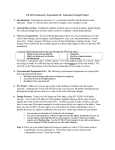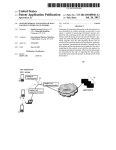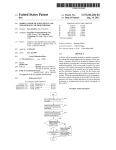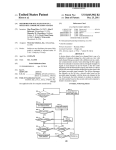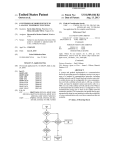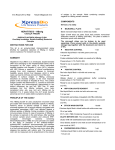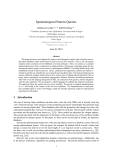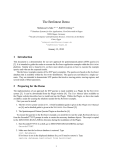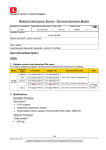Download Spatiotemporal annotation of data packets in wireless networks
Transcript
US008913552B2 (12) United States Patent (10) Patent N0.: (45) Date of Patent: Agrawal et a]. (54) SPATIOTEMPORAL ANNOTATION OF DATA 2006/0281437 A1 * PACKETS IN WIRELESS NETWORKS 2007/0067626 A1 2007/0168524 A1 2007/0286195 A1 * 2008/0090589 A1 * (75) Inventors: Dakshi Agrawal, Monsey, NY (U S); Chatschik Bisdikian, Chappaqua, NY 2008/0125959 2008/0187137 2008/0305747 2009/0054074 (Us) (73) Assignee: International Business Machines Corporation, Armonk, NY (US) (*) Notice: Subject to any disclaimer, the term of this patent is extended or adjusted under 35 Appl. No .: Dec. 16, 2014 Cook ....................... .. 455/4042 3/2007 Louis Briancon et a1. 7/2007 Chao et al. 12/2007 4/2008 Ilnickl et al. ................ .. 370/392 Mikan et al. ............. .. 455/4561 5/2008 Doherty et a1. Nikander et al. Aaron Aaron 8/2008 12/2008 2/2009 4/2009 10/2009 2/2010 Heater et al. Frazier GracieuX (Continued) U.S.C. 154(b) by 382 days. (21) A1 A1 A1 A1 2009/0104919 A1 2009/0248833 A1 2010/0048222 A1 12/2006 US 8,913,552 B2 OTHER PUBLICATIONS Calcev, G. et al., “Method and algorithm for near real time cellular 13/012,387 network optimization using antenna tilt control,” IP.com N0. (22) Filed: Jan. 24, 2011 (65) (52) (Continued) Prior Publication Data Us 2012/0188940 A1 (51) 1PCOM000132037D (Nov. 29, 2005). Int. Cl. H04 W 4/00 H04L 29/08 H04 W 4/18 US. Cl. Jul. 26, 2012 Primary Examiner * Brandon Renner Assistant Examiner * Faisal Choudhury (74) Attorney, Agent, or Firm * Preston Young; Michael I. (2009.01) (2006.01) (2009.01) Chang, LLC CPC ......... .. H04L 67/2819 (2013.01); H04W4/185 (2013.01) (58) USPC ................................ .. Field of Classi?cation Search CPC ......................... .. USPC 370/328 H04W 8/12; H04W 64/00 Rice eltlal reveals that spatiotemporal metadata is already present in the References Cited U.S. PATENT DOCUMENTS 2002/0023123 2005/0278375 2006/0069681 2006/0126645 4/2007 10/2008 aspect, a method for processing information streams pro duced by end-computing devices that are transmitted over a Wireless network having at least one network element is pro 541232011 370/328 See application ?le for complete search history. 7,203,752 B2 7,437,158 B2 tion information in Wireless networks are provided. In one vided. The method includes the following steps. Data packets which originate from the end-computing devices and are received by the network element are inspected for spatiotem poral metadata. Spatiotemporal metadata is inserted into the data packets and the data packets are transmitted if the step of inspecting the data packets reveals that the data packets are missing spatiotemporal metadata. Otherwise the data packets are transmitted if the step of inspecting the data packets ...................... .. ................................ .. (56) (57) ABSTRACT Techniques for annotating data packets with time and/or loca A1 2/2002 A1* 12/2005 Mitchko et a1. .......... .. 707/1041 A1 3/2006 Lauper A1* 6/2006 Devarapalli et a1. ........ .. 370/401 data Packets 18 Claims, 3 Drawing Sheets m I 302 PHASE 1 , 504 MW LOC'N‘RE LANE—SETUP SET LOCATlON NEIWORK ELEMENT —- PARAMETERS (LANE) l we INSPECT om PACKET FOR m —| LANE wms FOR DATA PACKETS I’— IUNE-OPERATION SPATIOTEMPORAL uEnom cousuu PERMISSION RULES 31o coumu PERMISSIBLE SPATIOTEMPORAL METADATA'i 312 no INSERT PERMISSIBLE SPATIOTEMPORAL umom 31 ‘ PHASE 11 YES US 8,913,552 B2 Page 2 (56) References Cited tional Conference on Convergence Information Technology, ICCIT 2007, Article No. 4420246, pp. 114-120, DOI 10.1109/ICCIT.2007. U.S. PATENT DOCUMENTS 254. (Jan. 1, 2007). 2011/0026464 A1* 2/2011 Chen et al. .................. .. 370/328 2011/0078287 A1* 3/2011 Pacella et al. 2011/0080843 A1* 2011/0161427 A1* 4/2011 6/2011 Casey et a1. ................. .. 370/252 Fortin et a1. ................. .. 709/206 2011/0246866 A1* 10/2011 Abajian et al. 2011/0302308 A1* 12/2011 Prodan et al. . 709/219 . 715/206 709/225 2012/0083289 A1* 4/2012 Li et al. ........ .. . 455/4561 2012/0096110 A1* 4/2012 Sadovsky et al. ........... .. 709/213 OTHER PUBLICATIONS Agosti, M. et al., “An Architecture for Sharing Metadata Among Geographically Distributed Archives,” Springer-Verlag, First Inter national DELOS Conference (Pisa, Italy), Digital Libraries: R&D, LNCS 4877, pp. 56-65. ISSN: 0302-9743 eISSN: 1611-3349 ISBN19783540770879 (2007). Kim, M. et al., “Web Services framework for geo-spatial services,” Springer-Verlag. 4th International Workshop on Web and Wireless Geographical Information Systems, W2GIS 2004 (Goyang Korea), Lecture Notes in Computer Science (Lect. Notes Comput Sci.) (Ger many) 2005 3428/-(1-13). ISSN: 0302-9743 (Sep. 19, 2005). Choi, O.H. et al., “A Design of Location Information Management System in Positioning Systems,” IEEE Computer Society, Interna * cited by examiner US. Patent Dec. 16, 2014 2: 20:5.“ a=6::2 ?g5 52 ca18-2w cuwz w 2 :52? I Sheet 1 0f 3 US 8,913,552 B2 US. Patent Dec. 16, 2014 Sheet 2 0f 3 US 8,913,552 B2 2N H w //:25: 826058 N.th §g mm358% 20:5th ?gmo zm 245 6“2.:”0 av2A05N.2:;me “23EN.s3w2t6h bv2Aom:<e E§E¢QME§S mEaz?m =v:5.Q5ng2A<u._6“5_n0< MEN "HmIwaEg 55522:on US. Patent Dec. 16, 2014 Sheet 3 0f3 US 8,913,552 B2 FIG. 3 w / f 302 PHASEI < I 304 INSTALL LOC-AWARE NETWORK ELEMENT LANE—SETUP SET LOCATION PARAMETERS (LANE) \ K ‘ [306 LANE WAITS FOR DATA PACKETS LANE—OPERATION 1 INSPECT DATA PACKET FOR /_ 308 SPATIOTEMPORAL METADATA I CONSULT PERMISSION RULES ’310 CONTAIN PERMISSIBLE SPATIOTEMPORAL METADATA? 312 PHASE 11 < YES INSERT PERMISSIBLE , 314 SPATIOTEMPORAL METADATA \ I FIG. 4 400 [410 / 420w PROCESSOR 425 NETWORK I/F / TO/FROM A ~ COMPUTER NETWORK 430w MEMORY MEDIA l/F |-----J'-----| 4404 DISPLAY : l- _______ ___l \435 ‘ MEDIA \450 US 8,913,552 B2 1 2 SPATIOTEMPORAL ANNOTATION OF DATA PACKETS IN WIRELESS NETWORKS cessing information streams produced by end-computing FIELD OF THE INVENTION the following steps. Data packets which originate from the devices that are transmitted over a wireless network having at least one network element is provided. The method includes end-computing devices and are received by the network ele ment are inspected for spatiotemporal metadata. Spatiotem poral metadata is inserted into the data packets and the data packets are transmitted if the step of inspecting the data packets reveals that the data packets are missing spatiotem poral metadata. Otherwise the data packets are transmitted if the step of inspecting the data packets reveals that spatiotem The present invention relates to location-aware wireless networks and more particularly, to techniques for annotating data packets with time and/or location information in such wireless networks. BACKGROUND OF THE INVENTION Enhanced availability of mobile Internet has resulted in a poral metadata is already present in the data packets. A more complete understanding of the present invention, hyper-growth of smart mobile applications. Many of these as well as further features and advantages of the present applications make use of spatially annotated information to provide a broad set of location-aware services such as ?nding the nearest (Greek) restaurant, or the nearest (cheap) gas station, targeted mobile advertisements, and so on. The intro invention, will be obtained by reference to the following duction of smart, sensing-enabling technologies can only hasten the growth trend of mobile applications. detailed description and drawings. BRIEF DESCRIPTION OF THE DRAWINGS 20 Many of these mobile applications can bene?t if their present invention; application (in the mobile device) or the application server (in the cloud or datacenter) is aware of the spatial coordinates of the information sources. If the source device is equipped with a global positioning system (GPS), it can attach geo-coordi nate metadata to application sessions. However, possessing GPS may not always be possible (due to form factors (i.e., anything related to the form characteristics of an object such as shape, size and weight), cost reasons, energy consumption, etc.) or GPS may not be always operational, e.g., in indoor environments. FIG. 2 is a diagram illustrating several exemplary ways by which a network element in a location-aware wireless net 25 work can attain location awareness according to an embodi ment of the present invention; FIG. 3 is a diagram illustrating an exemplary methodology for processing information streams produced by end-comput 30 ing devices that are transmitted over a network having at least one network element, such as the networks of FIGS. 1 and 2 according to an embodiment of the present invention; and FIG. 4 is a diagram illustrating an exemplary apparatus for Cellular network infrastructure can provide value-add by estimating device location and creating location metadata for processing information streams produced by end-computing the device. Traditional cellular base-stations can estimate device location using transmit power. Femto cells (e.g., in FIG. 1 is a diagram illustrating an exemplary location aware wireless network according to an embodiment of the devices that are transmitted over a network having at least one 35 homes) or pico cells (e.g., in malls), and WiFi hotspots (e.g., network element, such as the networks of FIGS. 1 and 2 according to an embodiment of the present invention. in airports) may be con?gured with location information. DETAILED DESCRIPTION OF PREFERRED EMBODIMENTS This information can be stored in a network provider’ s infra structure and become available through a location service to end-user applications. The location service can query the infrastructure of the provider to retrieve the location of the 40 As described above, in order to create open, smart, loca source, or an estimate of it, that can then be used to customize tion-enabled applications, the dependencies on existing loca the location service response to the user, for example, where tion infrastructures need to be reduced. Accordingly, pro vided herein are techniques that allow location-based services to exist independently of associating with a location infrastructure that must be queried for location information. The present techniques allow data streams to become spa a user uses her mobile telephone to connect to a location service provider, say, to search for movie theaters and movies near her location. The location service provider queries the cellular company provider for the location of the user. The 45 tiotemporally rich even when their sources are unable to cellular company provides this information using, for example, the cell tower information that the mobile telephone was connected to, assisted GPS, etc. As can be seen from this example, the location data and hence location services are intimately tied to the cellular provide the necessary metadata information. Further pro 50 vided herein are techniques to manage the content of meta data added to satisfy end-user preferences, such as privacy levels. company provider who will also typically own the relation According to the present techniques, the embedding is ship with the end-user. In other words, data of spatiotemporal performed by special network elements such as a WiFi base signi?cance become tied to a location infrastructure and the 55 station, a gateway, a sensor network controller, etc. These utility of these data is restricted by the access rights to that network elements examine the traf?c that passes through location infrastructure, e. g., requires access to location infor mation from a cellular company provider. them, for example using deep packet inspection (DPI), and if Therefore, the creation of open, smart, location-enabled applications, wherein the dependencies on existing location the network elements ?nd location metadata missing, the network elements insert on-the-?y the (estimated) location 60 information of the source in the data stream. FIG. 1, for example, is a diagram illustrating exemplary infrastructures are reduced would be desirable. location-aware network 100. Network 100, in this case a SUMMARY OF THE INVENTION wireless network, includes at least one end-computing device, i.e., user equipment (UE) 102, e.g., sensors, mobile The present invention provides techniques for annotating data packets with time and/or location information in wireless networks. In one aspect of the invention, a method for pro 65 telephones, personal digital assistants (PDAs), personal com puters, laptop computers, etc., accessing internet-based appli cations 106 though a network element(s) 104, such as by a US 8,9l3,552 B2 3 4 WiFi base station, a gateway, a sensor network controller and/ or a femto cell access point (FAP) located at a home of a user. An apparatus that may serve as a network element 104 is impermissible location metadata (e.g., violating set privacy policies), network element 104 can insert, remove and/or otherwise alter on-the-?y the (estimated) location informa provided in FIG. 4, described below. Information streams produced by the end-computing devices are transmitted over network 100. As will be described in detail below, according to the present teachings the network elements examine the information streams that pass therethrough, for example tion of the source and/or time data in the data stream. The concept of altering data packets on-the-?y is well known to those of skill in the art. By way of example only, writing on-the-?y is commonly done in routers which can even alter information as a packet waits to be transmitted on an outgoing using deep packet inspection (DPI), and if the network ele mation (e.g., spatial, temporal and/or spatiotemporal meta port. The router may, if necessary, momentarily delay the transmission to perform this operation. In FIG. 1, end-computing devices 102 (e.g., user equip ment (UE)) produce sensed information that is then con sumed by applications 106. As highlighted above, the user data) of the source in the information stream. The concept of equipment (UE) can include sensors. A sensor can be a deep packet inspection by network elements with capabilities simple, single task entities, a sensor in the strict sense, e.g., a hazmat sensor sensing presence and/ or concentration of haz ments ?nd location and/ or temporal metadata missing from application data-carrying packets, the network elements insert on-the-?y the (estimated) location and/or time infor to read data packets (including payload) is well known to those of skill in the art and thus is not described further herein. The information stream may also be referred to herein as data streams, with the understanding that the terms may be used interchangeably. As noted earlier, the insertion (or replace ment) of the spatiotemporal information in data packets is done only to application data-carrying packets. Depending on ardous material, a temperature sensor, a vibration sensor, an acoustic sensor, etc. A mobile telephone is an example of a multisensory device as it may include a microphone, an accel 20 the application context, there may not be a need to insert spatiotemporal information to data packets such as system management and control packets, set-up connection packets, sors carried by a person (a pedometer, a heartbeat sensor, a 25 etc., not meant to be “seen” and processed by end-user appli cations. In the example shown in FIG. 1, there are two ?ows of data, a ?rst ?ow and a second ?ow. The ?rst data ?ow (indicated by dashed arrows) involves end-computing devices that do not insert its location information as a proxy for the location of 30 embed location or time information in the data stream. These such as sensors and/or mobile telephones (which may be considered to be a type of sensor, see below). Network ele 40 data stream. Whether it is spatial metadata, temporal meta data or spatiotemporal metadata, if any, that gets embedded in the data stream depends on the design and application needs. For example, there may be a sensor system that reports infor 45 50 room level, the apartment level, building level, street block 55 noti?cation and mapping it to a location. Thus, in this case embedding spatial metadata would be preferable. In yet other cases, a more powerful sensor may be equipped with a global 60 location along with the time of a sensed event (such as the threshold crossing). In this instance, no additional spatial or temporal metadata is needed. By way of example only, network element 104 can be con?gured to examine the data that passes through it, for example using DPI, and if network element 104 ?nds location metadata missing, incorrect existing location metadata and/or information, the PAP could be con?gured by the user based on various criteria, so as to satisfy privacy concerns of the user. The FAP may be con?gured to embed home location information at various degrees of granularity, such as at the ?cation (ID) from the packet with the threshold crossing positioning system (GPS) device and thus can also add its capabilities. For example, the process of embedding may be in the data stream. For example, in the case of a FAP located at the home of a user that is con?gured to embed location location information. In this instance, embedding spatiotem was noted. An application tied to the sensor measurements would deduce the sensor location by reading a sensor identi latter set-up would be bene?cial for situations where the network element is moved, since it would not require any input from the user to update its location. Exemplary embodi ments involving such location-aware network elements (LANEs) are described in detail below. The location information may be coarse-grained or ?ne grained depending on user preferences and the localization policy-controlled (based, e.g., on a set of permission rules, see below) to de?ne the location granularity to be embedded may only provide the result of a temperature measurement (e.g., 22 degrees Celsius (0 C.)), and include no time or poral metadata would be preferable. In other occasions, a sensor may report threshold crossings it experiences. For example, the sensor may report that the temperature has just gone past 50° C. and provides only the time when this event address (or any other coarser/?ner location information, see below). Alternatively, the PAP can have access to GPS capa bilities and can determine its location automatically. The rent clock time read by the network element) and/or spa mation (e.g., temperature) only when the sensor system is explicitly queried by the application. In this case, the sensor the user equipment (UE) (with the assumption that the user is close by). Accordingly, network element 104 is preferably programmed with its location and/or has the capabilities to determine its location. By way of example only, with a FAP in a user’s home the user can program the PAP with a particular 35 and following consultation with privacy con?guration param eters (see below), embeds, if necessary, spatial (e. g., location information), temporal (e. g., a timestamp re?ecting the cur tiotemporal metadata (e.g., spatiotemporal metadata) in the body temperature sensor, etc.) and then pass this information to a remote health-care monitoring application. For the user equipment (UE) that does not embed location information into the data stream, network element 104 can end-computing devices can include user equipment (UE) ment 104, e.g., a FAP, upon inspection of the ?rst data ?ow, erometer, a GPS sensor and possibly a temperature sensor. Hence, the mobile telephone itself is the sensor. Alternatively, a Bluetooth®-equipped mobile telephone may collect infor mation from multiple wearable Bluetooth®-equipped sen level, neighborhood level or nothing at all. According to an exemplary embodiment, when the location information is coarse-grained the information includes only a home address resolved to GPS coordinates, and when the location informa tion is ?ne-grained the information has localization informa tion, i.e., relative to the home address, such as room level. A second data ?ow (indicated by a solid arrow in FIG. 1) involves end-computing devices (e. g., user equipment (UE)) that can collaborate to estimate, e.g., using triangulation, their local position, i.e., their location relative to each other. For 65 example, localization may be relative to a “local” coordinate system. Upon transmitting their data, these end-computing devices embed this relative location (localization informa US 8,913,552 B2 5 6 tion) in the data stream they transmit (i.e., to network element 104). Network element 104, upon inspecting the data stream, and following consultation with set privacy guidelines, may re?ne the localization information. For example, network “location awareness.” As described above, the present loca tion-aware network includes user equipment (UE) (not shown) accessing Intemet-based applications, in this case element 104 may alter the relative location to a global loca this case network element 204. As shown in FIG. 2, network tion (e.g., while the original location may be noted simply as “on the left side of the room,” the generic “room” may be replaced with speci?c information such as “kitchen”) or element 204 includes a downstream (incoming) port through which data packets arrive and an upstream (outgoing) port through which data packets are transmitted (see below). FIG. 2 illustrates three non-limiting exemplary methods by Internet applications 206, through a network element(s), in replace altogether the location information as in the case described above where the user equipment does not embed location information into the data stream. User equipment which network element 204 can acquire “location aware ness.” A location-aware network element is also referred to (UE) with location-awareness capabilities still only know a herein as a “LANE.” The ?rst method involves manual con relative location with respect to say a “generic” room. Net work element 104 may know that these devices are within the kitchen, so network element 104 can change the reference coordinate system from that of the room to that of the house. While network element 104 may insert, remove and/or ?guration of network element 204 by the user. Namely, a user directly enters an address (e.g., “30 Main Street”) through a LANE con?guration console (not shown) (e.g., through a web interface or a client application interfacing to the con ?guration module of the LANE). In the example shown in otherwise alter, supplement or replace the location informa FIG. 2, the user accesses the LANE con?guration console tion in the data stream as described above, other techniques may also be used to change the location information. In one through a web interface via the user’s personal computer (PC) 20 208. Optionally, network element 204 may consult with a exemplary embodiment, whenever network element 104 geospatial service (having a geospatial database (GeoSp db) identi?es missing (or non-complying, i.e., impermissible) 209) and substitute the address provided by the user with the location information in a data packet ?ow, network element GPS coordinates (latitude (lat) and longitude (long)) of the 104 can generate a brand new data packet to the same desti location, or of an area containing the location (increase the nation that includes the updated information (assuming that it 25 granularity). Google maps is such a geospatial service. With also clears any non-compliant information). Alternatively, in another exemplary embodiment, whenever network element Google maps, for example, a user can provide an address and retrieve the GPS coordinates of the address. For example, as 104 identi?es missing (or non-complying, i.e., impermis shown in FIG. 2, the user has provided the address “30 Main sible) location information, network element 104 replaces the data packet with the missing (or non-complying, i.e., imper Street” as its location and network element 204 consults a 30 missible) information with one that contains the allowable alternatively supplement) the location information from the location information and is otherwise identical to the original packet. The implementation of both of these functions in a DPI network element would be apparent to one of skill in the art. 35 As highlighted above, the present techniques address sev eral important aspects of spatiotemporal data transfer. The ?rst aspect is being able to allow location-based services to exist independently of associating with a location infrastruc ture that must be queried for location information. With ref erence to the description of FIG. 1 presented above, the 40 present techniques provide for the embedding of spatiotem poral metadata directly in the data (e. g., sensory data) stream. This would satisfy the ?rst aspect as applications and services can now extract the required spatiotemporal information geospatial service to obtain the GPS coordinates for 30 Main Street, which network element 204 can use to replace (or user. This option may also be bene?cial in situations where, for example, the user makes a mistake in inputting his/her location and/or when the location information the user inputs is not at the same granularity level as the set policy. By way of example only, if the privacy policy in place is set at a coarser granularity than what the user has inputted, the LANE can substitute its GPS readings for that of the user’s but at the correct privacy level. This would require that the network element provide location information of its own, i.e., aside from what the user provides. The second method involves a bootstrap, or assisted con 45 directly from the data stream without requiring querying for ?guration, i.e., wherein a network provider remotely sets the geospatial information for network element 204. Namely, a network service provider (having a con?guration server 210) location information from a third party, such as a cellular of the network to which network element 204 is connected company. The second aspect is allowing data streams to remotely con?gures network element 204 when network ele ment 204 powers on. According to an exemplary embodi become spatiotemporally rich even when their sources are unable to provide the necessary metadata information. Again with reference to the description of FIG. 1 presented above, 50 the present techniques provide for embedding spatiotemporal ment, an operator (from the network service provider) con sults a geospatial database (install db) of the locations of its installed LANEs (which may include actual subscribers’ home locations) and con?gures each LANE (remotely) metadata to a data stream by an entity other than the source of the stream. Serving as a surrogate of the source for the pur accordingly. data, spatiotemporal metadata becomes available to applica The third method involves self-con?guration (e.g., GPS, triangulation, etc.) by network element 204. In the third tions and services even when the source is unable to supply method, the LANE self-con?gures using GPS, triangulation the required information. The third aspect is managing the content of metadata added to satisfy end-user preferences, such as privacy levels.Again with reference to the description of FIG. 1 presented above, the present techniques provide for 60 information from other LANEs that already know their posi tion, etc. As highlighted above, the user equipment may be con?g ured to obtain sensory information from (stationary placed) sensors, e.g., placed in buildings, on roads, etc. As shown in 65 FIG. 2, sensory measurements obtained from these sensors are part of the data stream to the network element. Privacy guidelines may also be set at the sensor level. Independently of how a LANE acquires its location infor mation, end-users may set conditions of when and how to pose of enriching the data stream with spatiotemporal meta 55 using con?gurable permission lists describing the allowable information for embedding that are consulted prior to embed ding any metadata to the data stream. FIG. 2 is a diagram illustrating some exemplary ways by which a network element in a location-aware network (such as wireless network 100 of FIG. 1, described above) can attain US 8,913,552 B2 7 8 embed location information in data streams, labeled “Privacy with what frequency) spatiotemporal metadata may be inserted into the data packets. For example, the permission rules may dictate that spatiotemporal metadata may be con?guration” in FIG. 2. In FIG. 2 this is shown as part of the end-user manual con?guration of LANE, but alternatives are possible. As indicated in FIG. 2, through some client appli inserted into the data packet only once per source destination ?ow or only once per given interval of time, e.g., once every cation running on, e. g., a personal computer, a user can manu ally enter (type) the location information (e.g., “30 Main 10 minutes. This is done for ef?ciency sake, i.e., to prevent Street”) to be recorded in a sensory data stream. Likewise, taking duplicative actions. privacy policies/con?guration may be entered manually by a user through a client application. Such is the case, with social With regard to the second phase, in step 306, the LANE (e.g., network element 104) waits for data packets arriving at network privacy rules when, for example, a social network a downstream port, e.g., from the sensor side (see description user speci?es who can see updates in personal status infor of FIG. 2, above). Upon receipt of a data packet, in step 308, the LANE inspects the packet for time and location informa mation (friends, friends of friends, etc.). Spatial information tion (spatiotemporal metadata). This inspection may involve deep packet inspection (DPI) techniques, as the time and may be treated in a very similar way, and describe under what conditions (the clauses, see below) spatial information may be revealed. By way of example only, a service subscriber may provide her privacy constraints to the network provider location information will likely be embedded in the payload of the packet, e.g., within the payload portion of a transmis sion control protocol/internet protocol (TCP/IP) packet. who then con?gures LANE accordingly as part of a service agreement the network provider has with the subscriber. In FIG. 2, the privacy con?guration is shown as a collection of However, the packet inspection may also include shallow packet inspection, such as inspecting the TCP/IP packet head <if . . . then> rules, where represent conditions, such as origin 20 ers, to extract information that could be used later. Upon inspection of the packet, in step 310, the LANE consults the list of permission rules for the spatiotemporal of a data packet, destination of a data packet, application to which a data packet relates, time and date, etc., and <then> represent actions (shown in italics in FIG. 2) to be taken if the conditions are satis?ed. Example actions shown in FIG. 2 include, adjusting the location granularity embedded in the metadata in the packet and makes a determination as to 25 data stream, such as just a Zip code, or just a street name, or embed nothing, or even remove any geospatial information whether the packet contains permissible or impermissible spatiotemporal metadata. As described above, the LANE (e. g., network element 1 04) may be con?gured directly by the user with the user’s privacy guidelines and/or the privacy that might exist in the data stream. Using the example pro guidelines may be set at other levels, e. g., at the sensor. Note vided in FIG. 2, the user can designate that if the destination that even if the data packet does contain spatiotemporal meta data, the LANE may still consult the list of permission rules of the data packet is XYZ, then only Zip code location infor 30 mation should be inserted into the data stream. On the other to determine whether supplying spatiotemporal metadata is hand, if the data packet destination is ABC, then all location permissible (or impermissible). information is removed. For example, a user may share his/ her full location information to a localization service for packet contains permissible spatiotemporal metadata. If the summoning a taxi cab, but only provide coarse location infor mation that allows people to ?nd him/her (such as friends, In step 312, the LANE determines whether or not the data 35 LANE transmits the packet out on an upstream port (see FIG. 2). The LANE then returns to waiting for a next packet from downstream and steps 306-312 are repeated. On the other where the user does not necessarily want them to know exactly where he/ she is, but only that the user is in the area, or in the same town). If the user con?gures these ‘customized’ privacy settings, the user can specify speci?c destinations/ 40 settings, group s/types of destinations, etc. For example, a user may specify location expression granules such as full address, or just street name, or just Zip code, etc., and origin and destination groups, and then (using the client application) make statements of the form if data from group A are destined packet contains permissible spatiotemporal metadata (i.e., the data packet meets all of the privacy guidelines), then the hand, if the packet contains impermissible spatiotemporal metadata (i.e., the data packet violates the privacy guide lines), or if the packet contains insuf?cient or no spatiotem poral metadata at all, then in step 314 the LANE inserts/ embeds allowable (permissible) spatiotemporal metadata in 45 the packet accordingly and transmits the packet out an upstream port (see FIG. 2). Steps 306-312 are then repeated. While packet inspection may be performed at each incom ing packet, for example as in methodology 300, embedding of to group B allow location granule C. This is how social networks manage privacy rules for their content. FIG. 3 is a diagram illustrating an exemplary methodology 300 for processing information streams produced by end 100 described, for example, in conjunction with the descrip spatiotemporal metadata may occur only as often (or as fre quent) as necessary. For example, the LANE may embed permissible spatiotemporal metadata only once per source destination ?ow (identi?ed by a common TCP/IP address/ tion of FIGS. 1 and 2, above. Methodology 300 includes two phases, a ?rst phase (set-up of a LANE, steps 302 and 304) port source and destination pair), or over a given interval of time, e.g., once every 10 minutes. Or, as a result of DPI, the computing devices that are transmitted over a network having at least one network element, such as location-aware network and a second phase (operation of the LANE, steps 306-314). As describe above, LANE stands for location-aware network element (i.e., a network element that has “acquired” location awareness, see description of FIG. 2, above). With regard to the ?rst phase, in step 302, the LANE is installed. A LANE, such as network element 104 was described, for example, in 50 55 LANE may embed permissible spatiotemporal metadata once per application session, or over a given interval of time, e. g., once every 10 minutes for packets that appear to be part of the same application session. In this case, the step of “insert permissible spatiotemporal metadata” is preceded by a deter 60 mination of whether embedding is necessary for reasons such conjunction with the description of FIG. 1, above. In step 304, the LANE (e.g., network element 104) is con?gured (“set as the aforementioned ?ow or session rules. location parameters”) such as acquiring location information spatiotemporal metadata” can be interpreted quite generically It is notable that in step 312, the term “contain permissible based on what permissible is. Permissible will include both for the LANE and con?guring the <if . . . then> privacy rules (see, for example, the description of FIG. 2, above), referred to more generally as permission rules below. As described in detail below, the permission rules may also dictate when (i.e., 65 the granularity of spatial information and also when the infor mation can be permitted to be written. Hence, the example above of writing a speci?c piece of information every 10 US 8,913,552 B2 9 10 minutes is an example of when a piece of spatial information can be written. To be a little more speci?c, by way of example a program con?gured to inspect data packets which originate from the end-computing devices and are received by the network element for spatiotemporal metadata; and insert spa tiotemporal metadata into the data packets and transmit the data packets if the step of inspecting the data packets reveals that the data packets are missing spatiotemporal metadata, otherwise transmit the data packets if the step of inspecting the data packets reveals that spatiotemporal metadata is already present in the data packets. only, there might be various authors of permission conditions. For example, end-users may specify content permissions (what location information can be added), operators may also provide operation permissions (when a location metadata can be added in an information stream). A LANE device will aggregate these permissions and when it performs step 312 the LANE device will decide what needs to be altered with regard to spatial metadata. Thus, the permission rules, con The machine-readable medium may be a recordable medium (e.g., ?oppy disks, hard drive, optical disks such as sulted in step 310 (above), may contain an aggregation of permission rules from end-users and operators that determine removable media 450, or memory cards) or may be a trans the spatial information provided and the frequency by which mission medium (e.g., a network comprising ?ber-optics, the the information is provided in the sensory streams. The above exemplary embodiments have considered the world-wide web, cables, or a wireless channel using time division multiple access, code-division multiple access, or embedding or updating of permissible spatial information in other radio-frequency channel). Any medium known or information streams passing through a network element such as network elements 104 or 204 employing techniques such as DPT. In an entirely analogous manner, permissible tempo developed that can store information suitable for use with a ral information can also be embedded or updated in informa tion streams. A network element, such as network elements 104 or 204, can employ a technique such as DPI to inspect a 20 430 could be distributed or local and the processor device 420 could be distributed or singular. The memory 430 could be implemented as an electrical, magnetic or optical memory, or any combination of these or other types of storage devices. passing packet for temporal information. If temporal infor mation is missing, a timestamp may be entered based on the time indicated by the internal clock of the network element. A user may con?gure the formatting details of the time, for example, to provide both time and date information, or only time, or con?gure the time granularity to be in minutes, sec onds, milliseconds, etc. Note, that contrary to spatial infor mation, time information can be, in general, more reliably 25 network, accessible through network interface 425, is still 30 within memory 430 because the processor device 420 can 35 retrieve the information from the network. It should be noted that each distributed processor that makes up processor device 420 generally contains its own addressable memory space. It should also be noted that some or all of computer system 410 can be incorporated into an application-speci?c be less crucial than in the case of spatial information. None theless, the same techniques employed for providing permis or general-use integrated circuit. Optional video display 440 is any type of video display also be used to provide permission rules for temporal infor mation used to con?gure rules for when to write and how to suitable for interacting with a human user of apparatus 400. Generally, video display 440 is a computer monitor or other write (i.e., format) time information. Turning now to FIG. 4, a block diagram is shown of an apparatus 400 for implementing one or more of the method 40 ologies presented herein. By way of example only, apparatus that various other changes and modi?cations may be made by 45 mitted over a wireless network having at least one network element such as location-aware network 100 described, in conjunction with the description of FIGS. 1 and 2. As high by an application on end-computing devices that are trans 50 network 100. end-computing devices and are received by the network element for spatiotemporal metadata in the data packets Apparatus 400 comprises a computer system 410 and removable media 450. Computer system 410 comprises a 55 410 to interact with media, such as a hard drive or removable 60 herein may be distributed as an article of manufacture that itself comprises a machine-readable medium containing one or more programs which when executed implement embodi ments of the present invention. For instance, when apparatus 400 is con?gured to implement one or more of the steps of methodology 300 the machine-readable medium may contain themselves; consulting user-con?gurable permission rules that dictate network, while media interface 435 allows computer system media 450. As is known in the art, the methods and apparatus discussed mitted over a wireless network having at least one network element, the method comprising the steps of: inspecting, on the ?y, data packets which originate from the con?gured to serve as one or more of the network elements in processor device 420, a network interface 425, a memory 43 0, a media interface 435 and an optional display 440. Network interface 425 allows computer system 410 to connect to a one skilled in the art without departing from the scope of the invention. What is claimed is: 1. A method for processing information streams produced lighted above, network 100 includes at least one network element (e.g., network element 104). Apparatus 400 can be similar video display. Although illustrative embodiments of the present invention have been described herein, it is to be understood that the invention is not limited to those precise embodiments, and 400 can be con?gured to implement one or more of the steps of methodology 300 of FIG. 3 for processing information streams produced by end-computing devices that are trans Moreover, the term “memory” should be construed broadly enough to encompass any information able to be read from, or written to, an address in the addressable space accessed by processor device 420. With this de?nition, information on a estimated by a recipient application by simply using its own local clock. Hence, providing rules for temporal privacy may sion rules, such as using a browser application on a PC con nected to the con?guration module of a network element, can computer system may be used. Processor device 420 can be con?gured to implement the methods, steps, and functions disclosed herein. The memory 65 what spatiotemporal metadata is permissible and what spatiotemporal metadata is impermissible for the appli cation; and inserting spatiotemporal metadata into the data packets themselves in accordance with the user-con?gurable permission rules and transmitting the data packets if the step of inspecting the data packets reveals that the data packets are missing spatiotemporal metadata, otherwise conforming existing spatiotemporal metadata with the user-con?gurable permission rules and transmitting the data packets if the step of inspecting the data packets US 8,913,552 B2 11 12 reveals that spatiotemporal metadata is already present in the data packets themselves, wherein the user-con?gurable permission rules further designate a granularity of spatiotemporal metadata 12. The method of claim 1, further comprising the step of: con?guring the network element with the permission rules. 13. The method of claim 1, wherein the step of inspecting the data packets is performed by the network element using deep packet inspection. inserted into the data packets depending on one or more of an origin of the data packets, a destination of the data 14. The method of claim 1, further comprising the step of: packets, application to which the data packets relate, time, and date, and wherein the steps of inserting and conforming are performed only for application data carrying packets meant to be processed by end-user removing the spatiotemporal metadata already present in the data packets if the spatiotemporal metadata already present in the data packets is impermissible. 15. The method of claim 1, wherein the step of inspecting the data packets reveals that spatiotemporal metadata is already present in the data packets themselves, and wherein applications. 2. The method of claim 1, wherein the step of inserting spatiotemporal metadata into the data packets comprises the step of: inserting permissible spatiotemporal metadata into the data packets and transmitting the data packets if the step of inspecting the data packets reveals that the data pack the step of conforming the existing spatiotemporal metadata with the user-con?gurable permission rules comprises the ets are missing spatiotemporal metadata or contain impermissible spatiotemporal metadata, otherwise transmitting the data packets if the step of inspecting the data packets reveals that spatiotemporal metadata is already present and that the spatiotemporal metadata present is permissible. 20 the step of conforming the existing spatiotemporal metadata with the user-con?gurable permission rules comprises the 3. The method of claim 1, wherein the permission rules are related to privacy guidelines regarding the spatial metadata in the data packet. 25 4. The method of claim 1, further comprising the step of: produced by an application on end-computing devices are transmitted, the network having at least one network element 30 at least one processor device, coupled to the memory, 5. The method of claim 4, wherein the permission rules include inserting spatiotemporal metadata into the data pack ets once per source destination ?ow or over a given interval of 35 time. 6. The method of claim 4, wherein the step of inserting 40 impermissible spatiotemporal metadata, otherwise 45 7. The method of claim 1, wherein the network element comprises at least one of a WiFi base station, a gateway, a sensor network controller and a femto cell access point. 50 8. The method of claim 1, further comprising the steps of: con?guring the network element with spatial metadata related to a location of the network element; and using the spatial metadata for the network element to supplement or replace the spatiotemporal metadata 55 already present in the data packets. 9. The method of claim 8, wherein the step of con?guring the network element is performed by a user of one of the end-computing devices. 60 10. The method of claim 8, wherein the step of con?guring the network element is performed remotely by a network using global positioning system information. end-computing devices and are received by the net work element for spatiotemporal metadata in the data consult user-con?gurable permission rules that dictate what spatiotemporal metadata is permissible and what spatiotemporal metadata is impermissible for the application; and insert spatiotemporal metadata into the data packets themselves in accordance with the user-con?gurable permission rules and transmit the data packets if the step of inspecting the data packets reveals that the data packets are missing spatiotemporal metadata, other wise conform existing spatiotemporal metadata with the user-con?gurable permission rules and transmit the data packets if the step of inspecting the data packets reveals that spatiotemporal metadata is already present in the data packets themselves, wherein the user-con?gurable permission rules further designate a granularity of spatiotemporal metadata inserted into the data packets depending on one or more of an origin of the data packets, a destination of the data packets, application to which the data packets relate, time, and date, and wherein the insert and conform steps are performed only for application data-carrying packets meant to be processed by end user applications. 18. An article of manufacture for processing information streams produced by an application on end-computing service provider of a network to which the network element is connected. 11. The method of claim 8, wherein the step of con?guring the network element is performed by the network element operative to: inspect, on the ?y, data packets which originate from the packets themselves; ets are missing spatiotemporal metadata or contain transmitting the data packets if the step of inspecting the data packets reveals that spatiotemporal metadata is already present and that the spatiotemporal metadata present is permissible. comprising: a memory; and permission rules. spatiotemporal metadata into the data packets comprises the step of: inserting permissible spatiotemporal metadata into the data packets and transmitting the data packets if the step of inspecting the data packets reveals that the data pack step of: removing the existing spatiotemporal metadata to conform with the user-con?gurable permission rules. 17. A wireless network over which information streams consulting permission rules that dictate when spatiotem poral metadata may be inserted into the data packets, and wherein the step of inserting spatiotemporal metadata into the data packets is performed in accordance with the step of: modifying the existing spatiotemporal metadata to con form with the user-con?gurable permission rules. 16. The method of claim 1, wherein the step of inspecting the data packets reveals that spatiotemporal metadata is already present in the data packets themselves, and wherein devices that are transmitted over a wireless network having at 65 least one network element comprising a non-transitory machine-readable recordable medium containing one or more programs which when executed implement the steps of: US 8,913,552 B2 13 inspecting, on the ?y, data packets Which originate from the end-computing devices and are received by the network element for spatiotemporal metadata in the data packets themselves; consulting user-con?gurable permission rules that dictate 5 What spatiotemporal metadata is permissible and What spatiotemporal metadata is impermissible for the appli cation; and inserting spatiotemporal metadata into the data packets themselves in accordance With the user-con?gurable 10 permission rules and transmitting the data packets if the step of inspecting the data packets reveals that the data packets are missing spatiotemporal metadata, otherWise conforming existing spatiotemporal metadata With the user-con?gurable permission rules and transmitting the 15 data packets if the step of inspecting the data packets reveals that spatiotemporal metadata is already present in the data packets themselves, Wherein the user-con?gurable permission rules further designate a granularity of spatiotemporal metadata 20 inserted into the data packets depending on one or more of an origin of the data packets, a destination of the data packets, application to Which the data packets relate, time, and date, and Wherein the steps of inserting and conforming are performed only for application data- 25 carrying packets meant to be processed by end-user applications.












